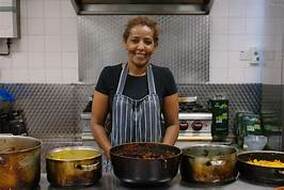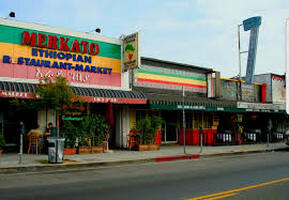I will recommend a few Ethiopian restaurants in the western U.S. where we have enjoyed wonderful meals. Meanwhile, you should be able to find good Ethiopian food in your own area by doing just a little research on line. If you live anywhere near Washington, D.C., you will find an abundance of riches. But first, let’s survey the basics of Ethiopian cuisine and food etiquette.
The staples of Ethiopian food are injira, a spongy sourdough flatbread, and wat (sometimes spelled wot,) a thick, spicy stew. Wat can be made with beef, lamb, chicken, goat, lentils or chick peas, but never pork or shell fish, as consuming these ingredients is forbidden by the Ethiopian Orthodox Church. This ancient Christian community also fasts from eating any animal products on Wednesdays, Fridays and the entire season of Lent, so many delicious vegan dishes are easy to find on Ethiopian restaurant menus. Also, since the season of Lent begins in March, other Christians who abstain from eating meat on Fridays during Lent will find a happy home with Ethiopian food as this year’s fasting season begins.
The traditional flavorings for wat are berbere, a complex spice mix, and niter kibbeh, a spiced, clarified butter similar to ghee, which is used in Indian cuisine. For both berbere and niter kibbeh, you can make your own or buy them at an Ethiopian market. Both items are also available on Amazon.com.I made my own from a Cooking Channel recipe by Miriam Garron when I made Ethiopian Red Lentils (misr wat) at home. The result was delicious, but the project took a lot of pre-planning, as the spices required were not all in my home cupboard and required a trip to Whole Foods, where I was able to find most of the ingredients; unfortunately, I have not yet found an Ethiopian market on the island of Oahu. Some of the spices you will need include: whole cloves, cinnamon sticks, allspice berries, fenugreek seeds, turmeric, black cardamom pods, coriander seeds, copious amounts of paprika, various types of chili powder, and fresh onions, ginger and garlic. Needless to say, you will also need a spice grinder.
Preparing the misr wat was also time consuming, as the spiced butter (niter kibbeh) needs to be simmered for at least half an hour, then strained through cheesecloth, leaving behind the milk
solids. You can grind up the spice mix (berbere) while the butter is simmering, but some of the spices will need to be toasted before they are ground to a fine powder. Only after the butter and spice mix have been prepared can you make the red lentils, which are simmered with onions, garlic and fresh ginger, pre-cooked in niter kibbeh, then seasoned with berbere and kosher salt. I surveyed several recipes for misr wat before choosing to make Ms. Garron’s version. The exact combination of seasonings for both the spice mix and the flavored butter varies widely from recipe to recipe, and several of the recipes I viewed included either chopped fresh tomatoes or tomato paste. In any case, misr wat is intended to be part of a larger meal that could include spiced cabbage with carrots, salad, flavored greens, such as kale, other legume or potato dishes and chicken or beef.
All of these items are served with injira, the ubiquitous sourdough flatbread, resembling a thin, spongy rolled up pancake. Injira is made from the fermented flour of the teff plant, an ancient grain that is indigenous to Ethiopia. When Ethiopian restaurants first started appearing in America, injira was an acquired taste for many. It can have a somewhat sour flavor which can be unpleasant to those who did not grow up eating it. However, I have noticed that over time, Ethiopian restaurants seem to have done something to temper the sourness of the injira they serve to cater to American tastes. I even found a recipe on line for injira that contains no teff whatsoever and instead is made from buckwheat pancake mix and a few other ingredients easily found in your cupboard and refrigerator. I will share this recipe at the end of this blog with the caveat that you will not be creating authentic Ethiopian injira, but an Americanized version that is a quick and easy substitute for the real thing. I apologize in advance to Ethiopian chefs who actually know how to make injira.
It’s fun to try making Ethiopian food at home, but in fact, you will find the best Ethiopian food in the homes of Ethiopian people or in good Ethiopian restaurants. Let’s learn a little etiquette before we show up at the neighborhood Ethiopian restaurant. The first thing to remember when eating Ethiopian food is to wash your hands in the sink provided or the restroom as soon as you have ordered your food, as you will be eating with your hands along with everyone else at the table. The food will be served on top of a big round piece of injira on a large communal platter with additional rolls of injira on a separate plate. Tear off a piece of injira with your fingers and use it to surround a bite of wat; then pop the whole thing into your mouth. Eat only with your right hand, as using your left hand for shaking hands or eating is considered disrespectful. Wash your hands again at the end of the meal.
Many Ethiopian restaurants offer the traditional Coffee Ceremony at the end of the meal. Coffee drinking originated in Ethiopia, and coffee was first cultivated there. The ceremony is an elaborate and ritualized social activity in which the coffee will be roasted, ground and brewed in a clay pot called a jebena. Guests may be seated on the floor or on stools for this lovely and leisurely activity that can take more than an hour.
When we lived in California, we loved the Ethiopian food at Zeni (1320 Saratoga Avenue, San Jose,) an authentic restaurant with two rooms—one with western-style tables and chairs and one with low stools where guests eat communally from low, basket-like tables in the traditional style. The food at Zeni is divine, and the menu encompasses a wide variety of vegetarian and meat dishes. My favorite has always been the vegetarian combination, which includes tantalizing little piles of several different and well-balanced vegetable dishes artistically arranged on a giant injira. Misr wat is always included in any Ethiopian vegetarian combination plate. If you wish to dine at Zeni, which I strongly recommend, be patient, as it is a very popular place, and they do not take reservations.

When we moved to Hawaii, we were thrilled to discover Ethiopian Love Restaurant, located in Honolulu’s Chinatown at 1112 Smith Street. We adore the food there and have returned many times. The owner told us that he is familiar with Zeni in San Jose and holds Zeni up as a model Ethiopian restaurant to emulate. Ethiopian Love is well on its way. The food is always consistently outstanding, and the menu includes well-prepared beef, lamb and chicken dishes as well as wonderful vegetarian selections. One of the veggie samplers, which can be ordered for one or two people, includes six different vegetable preparations served on injira. Some of the vegetarian dishes listed on Ethiopian Love’s menu include misr wot (of course,) kik alicha wot (yellow split peas,) atakilt wot, (cabbage and carrots with turmeric, garlic and ginger, another of my favorites,) and romi (mushrooms cooked in berbere.)
We were surprised to discover a dessert item on Ethiopian Love’s menu simply called peanut tea. This turned out to be a true delight, and we now order it every time we dine there. Imagine drinking a very hot and thick concoction of peanut butter, honey and a small amount of tea, poured from an elegant teapot into attractive china cups. This is pretty much all of my childhood tea party fantasies rolled into one. I have since learned that peanut tea is a real thing in Ethiopia and can be ordered in Ethiopian coffee shops or made at home by simply mixing peanut butter with hot water and honey until you like the taste and texture.
Ethiopian flatbread, known as injira, should be very thin with a spongy texture. It needs to tear easily and be firm enough to use as a “utensil” to pinch pieces of food off the plate. You can make injira in your skillet or crepe pan at home. Use your own judgment as you add club soda to produce a thin batter that will not end up making fluffy buckwheat pancakes instead of injira.
- 1 cup buckwheat pancake mix
- ¾ cups flour
- 3 teaspoons baking powder
- 2 cups of club soda (more or less to produce a thin batter)
- ½ teaspoon salt
- 1 large beaten egg
- 2 tablespoons of butter for the pan (more as needed)
Special Equipment: large mixing bowl, wooden spoon, sieve or flour sifter, large skillet or crepe pan, 1 or 2 offset spatulas, large platter
Makes: 8-10 thin rounds of injira
- Using a sieve or a flour sifter, sift the pancake mix, flour, baking powder and salt together into a large bowl. Add the beaten egg and 1 cup of club soda, stirring with a wooden spoon to form a smooth batter. Add more club soda to create a runny batter.
- Heat 2 tablespoons of butter on medium in a heavy skillet or crepe pan. When the butter starts to bubble, pour in enough batter to cover the bottom of the pan in a thin layer.
- Cook for 2 minutes until the top starts looking bubbly. Turn the injira over with an offset spatula (it may be easier to use 2 spatulas) and cook for 2 more minutes. Both sides should be a light golden brown.
- Repeat this process, stacking the rounds of injira on a large platter and adding butter to the skillet as needed.
- To serve, roll up the injiras into thin coils and cut them into pinwheels about 2 inches wide. Save 1 flat injira to line the serving platter you will be using to serve the wat and other Ethiopian food items you have prepared.














 RSS Feed
RSS Feed